Don't wanna be here? Send us removal request.
Photo
Great work of summary here. Definitely worth a read if anyone’s curious about Turks’ role in AC: Universe and real history some centuries after Seljuk Era. It’s worth noting that games took a lot of things wrong, one such maybe Selim killing his brother by throwing him off the cliff. In real life, Turks believed that the blood of the royal family was blessed by the “kut” brought by their god/gods(one of which is a phoenix known as Turul/Tugrul) as long as that family continues to rule. So spilling royal blood was a huge crime even to royals themselves. This is why most of the family slaughter happened in a way that doesn’t require any bloodshed, like, choking their parents, siblings and children. Well... We weren’t much of a cheery bunch, back then.

In Game:
The Ottoman Empire was a Turkish state that ruled over most of the territories of the former Byzantine Empire and beyond, with Constantinople as its capital.
In 1476, the Ottomans under the Grand Vizier Ishak Pasha participated in a military crackdown on a Hungarian uprising, entering a war with Wallachia and defeating the rebel prince, a Templar named Vlad Tepes.
During the later half of the 15th century, the Ottomans brokered a truce with the Assassins, via their leader Ishak Pasha, who was also a secret Assassin himself. This act led Vali cel Tradat to defect to the Templars, after he had served the Assassins for nearly a decade, as he considered the truce with the Ottomans and Assassins as a betrayal of his Wallachian heritage.
Sultan Bayezid II led the Ottomans into a war with the remnants of the Byzantine Empire, led by Manuel Palaiologos, a Templar, who was attempting to reclaim the empire and restore it to its Byzantine roots.
While Bayezid had originally chosen his son Ahmet as the next Sultan, he soon faced fierce opposition from the Ottoman Janissaries, who supported his other son, Selim, and aided him in his bid for ascension to the throne. Selim then begun a tough war against his father in order to force him to abdicate the title of Sultan. In 1512, Bayezid eventually handed over the throne to Selim instead of Ahmet, and Selim became the new Sultan of the Ottoman Empire.
As soon as he became the Sultan, Selim and his Janissary army marched their way towards Constantinople, where they found Selim’s brother Ahmet facing off against the Assassin Ezio Auditore da Firenze. As he approached his brother, Selim revealed to Ahmet that their father had ultimately chosen him as his successor, before he began to strangle Ahmet and eventually pushed him off a nearby cliff, killing him.
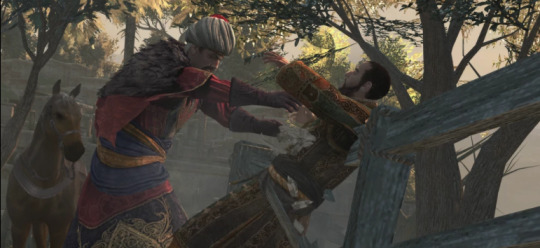
It was his reasoning that Ahmet, who was secretly a high-ranked member of the Templars, had betrayed the Ottomans when he formed an alliance with the Byzantines.
In 1520, a tragedy robbed Selim of the Sultanate, and Suleiman, aged 26, succeeded him. His reforms greatly improved the Empire’s bureaucratic system, which would later be described as a “well-oiled engine,” despite its significant size.
During his rule, Suleiman expanded his Empire to its furthest points, stretching it from Algeria to the Persian Gulf, and from Austria down to Egypt. Respecting the diversity of those under his authority, he was always careful to honor their cultures, traditions, and religions.
In Real Life:
The Ottoman Empire was created by Turkish tribes in Anatolia (Asia Minor) that grew to be one of the most powerful states in the world during the 15th and 16th centuries. The Ottoman period spanned more than 600 years and came to an end only in 1922, when it was replaced by the Turkish Republic and various successor states in southeastern Europe and the Middle East. At its height the empire encompassed most of southeastern Europe to the gates of Vienna, including present-day Hungary, the Balkan region, Greece, and parts of Ukraine; portions of the Middle East now occupied by Iraq, Syria, Israel, and Egypt; North Africa as far west as Algeria; and large parts of the Arabian Peninsula. The term Ottoman is a dynastic appellation derived from Osman I (Arabic: ʿUthmān), the nomadic Turkmen chief who founded both the dynasty and the empire about 1300.
The first period of Ottoman history was characterized by almost continuous territorial expansion, during which Ottoman dominion spread out from a small northwestern Anatolian principality to cover most of southeastern Europe and Anatolia. The political, economic, and social institutions of the classical Islamic empires were amalgamated with those inherited from Byzantium and the great Turkish empires of Central Asia and were reestablished in new forms that were to characterize the area into modern times.
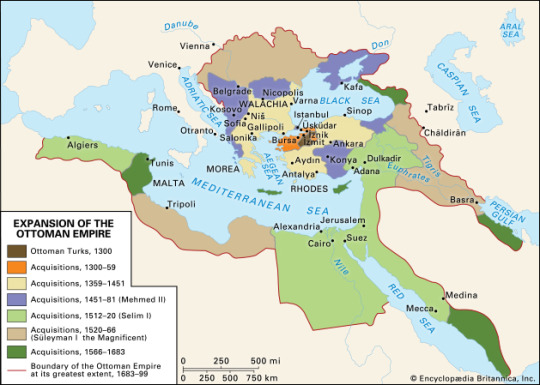
In their initial stages of expansion, the Ottomans were leaders of the Turkish warriors for the faith of Islam, known by the honorific title ghāzī (Arabic: “raider”), who fought against the shrinking Christian Byzantine state. The ancestors of Osman I, the founder of the dynasty, were members of the Kayı tribe who had entered Anatolia along with a mass of Turkmen Oğuz nomads. Those nomads, migrating from Central Asia, established themselves as the Seljuq dynasty in Iran and Mesopotamia in the mid-11th century, overwhelmed Byzantium after the Battle of Manzikert (1071), and occupied eastern and central Anatolia during the 12th century. The ghazis fought against the Byzantines and then the Mongols, who invaded Anatolia following the establishment of the Il-Khanid (Ilhanid) empire in Iran and Mesopotamia in the last half of the 13th century. With the disintegration of Seljuq power and its replacement by Mongol suzerainty, enforced by direct military occupation of much of eastern Anatolia, independent Turkmen principalities—one of which was led by Osman—emerged in the remainder of Anatolia.
Ottoman dynasts were transformed from simple tribal leaders to border princes (uc beys) and ghazi leaders under Seljuq and then II-Khanid suzerainty in the 13th and early 14th centuries. With the capture of Bursa, Orhan had been able to declare himself independent of his suzerains and assume the title of bey, which was retained by his successors until Bayezid I was named sultan by the shadow ʿAbbāsid caliph of Cairo following his victory over the Christian Crusaders at the Battle of Nicopolis (1396). Those title changes reflected changes in the position of the Ottoman ruler within the state and in the organization of the state itself.
As the territory of the Ottoman principality expanded, however, and the Ottomans inherited the administrative apparatus left by the Byzantines, that simple tribal organization was replaced by a more complex form of government. By the time the Ottoman rulers became sultans, they already had far more extensive power and authority than had been the case a half century earlier. The simple tribal organization of the Ottoman bey could suffice only while the state was small enough for the individual tribal leaders to remain on their lands to collect their revenues and fight the nearby enemy at the same time. As the empire expanded and the frontiers and enemies became further removed from previously conquered territory, the financial and administrative functions at home had to be separated from the military. Taxes had to be collected to exploit the conquered territories and support the officers and soldiers while they were away. The treasury of the sultan had to be separated from that of the state so that each would have an independent income and organization.
Throughout the 14th and 15th centuries, therefore, the Ottoman state gradually reshaped its government and military institutions to meet the needs of administering and defending an expanding empire. That process naturally was influenced by those states that had preceded the Ottoman Empire, not only in the areas it came to rule but also in the lands of its ancestors. So it was that the developing Ottoman state was influenced by the traditions of the nomadic Turkic empires of Central Asia, particularly in military organization and tactics. It was also heavily influenced by the classical high Islamic civilization of the ʿAbbāsids, as passed through the hands of the Seljuqs, particularly in the development of orthodox Islam as the basis of its administrative, religious, legal, and educational institutions and in the organization of its financial systems. In the court hierarchy, the central financial structure, and the tax and administrative organizations developed in the European provinces, the Ottomans were influenced by the Byzantines and, to a lesser extent, by the Serbian and Bulgarian empires. Although conversion to Islām was not demanded of the conquered, many Christians and a few Jews voluntarily converted to secure full status in the new empire. Most, however, continued to practice their old religions without restriction.
A particularly important source of Christian influence during the 14th century came from the close marriage ties between the Ottoman and Christian courts. Orhan was married to the Byzantine princess Nilüfer, mother of Murad I. Murad married Byzantine and Bulgarian princesses, and Bayezid I married Despina, daughter of the Serbian prince Lazar. Each of those marriages brought Christian followers and advisers into the Ottoman court, and it was under their influence that Bayezid I abandoned the simple nomadic courts and practices of his predecessors and isolated himself behind elaborate court hierarchies and ceremonies borrowed primarily from the Byzantines, setting a pattern that was continued by his successors. The triumph of Sultan Mehmed I in 1413 was at least in part because of the support of the Turkish notables and Muslim religious orders of Anatolia, who strongly resented the Christian predominance in Bayezid’s court and attributed his abandonment of the ghazi tradition and attacks in Turkish Muslim Anatolia—as well as the defeat at the hands of Timur—to Christian influence. As a result, Turkish and Muslim influences dominated the Ottoman court during the 15th century, although the hierarchies, institutions, and ceremonies introduced in the previous century remained largely unchanged.
During the century that followed the reign of Mehmed II, the Ottoman Empire achieved the peak of its power and wealth. New conquests extended its domain well into central Europe and throughout the Arab portion of the old Islamic caliphate, and a new amalgam of political, religious, social, and economic organizations and traditions was institutionalized and developed into a living, working whole.
Whereas Bayezid had been put on the throne by the Janissaries despite his pacific nature and carried out military activities with reluctance, Selim I (ruled 1512–20) shared their desire to return to Mehmed II’s aggressive policy of conquest. But Selim did not wish to be dependent on or controlled by those who had brought him to power, so he killed not only all of his brothers but also all seven of their sons and four of his own five sons, leaving only the ablest, Süleyman, as the sole heir to the throne.
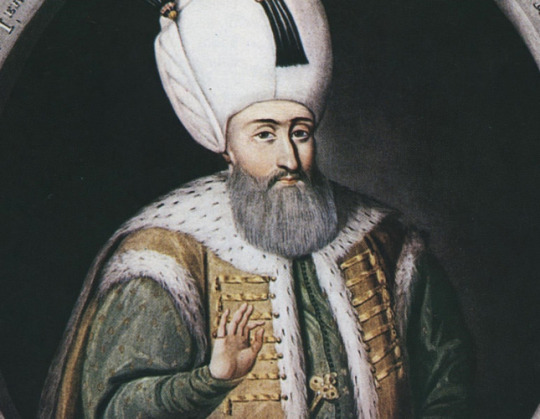
(Image source)
Throughout Sultan Suleiman’s rule, the empire expanded and included areas of Eastern Europe. At its height, the Ottoman Empire included the following regions: Turkey, Greece, Bulgaria, Egypt, Hungary, Macedonia, Romania, Jordan, Palestine, Lebanon, Syria, some of Arabia, and a considerable amount of the North African coastal strip.
Starting in the 1600s, the Ottoman Empire began to lose its economic and military dominance to Europe.
Around this time, Europe had strengthened rapidly with the Renaissance and the dawn of the Industrial Revolution. Other factors, such as poor leadership and having to compete with trade from the Americas and India, led to the weakening of the empire. In 1683, the Ottoman Turks were defeated at the Battle of Vienna. This loss added to their already waning status. Over the next hundred years, the empire began to lose key regions of land. After a revolt, Greece won their independence from the Ottoman Empire in 1830. In 1878, the Congress of Berlin declared the independence of Romania, Serbia and Bulgaria.
During the Balkan Wars, which took place in 1912 and 1913, the Ottoman Empire lost nearly all their territories in Europe.
At the start of World War I, the Ottoman Empire was already in decline. The Ottoman Turks entered the war in 1914 on the side of the Central Powers (including Germany and Austria-Hungary) and were defeated in 1918.
Under a treaty agreement, most Ottoman territories were divided between Britain, France, Greece and Russia.
The Ottoman empire officially ended in 1922 when the title of Ottoman Sultan was eliminated. Turkey was declared a republic in 1923.
Keep reading
14 notes
·
View notes
Text
Episode 2 Progress
Assassin’s Creed Ressurrection’s Episode 2 is about 30% done. Follow Ashina Tugrul’s story into medieval Iran, how he met the future founder of Assassin Order, Hasan Sabbah, and what role Persian mathematician, poet and ladies man Omer Khayyam played in them crossing paths with Bayek’s legacy.
#assassin's creed: resurrection#Assassin's Creed#assassin's creed fanfiction#turkish assassins#persian assassins
0 notes
Photo
Look at their cute murder smiles. Just... look at them...



1K notes
·
View notes
Photo

I hope Tumblr will get this meme.
1 note
·
View note
Text
Assassin’s Creed: Resurrection
Chapter 1 - Blue of Skies, Blue of Domes
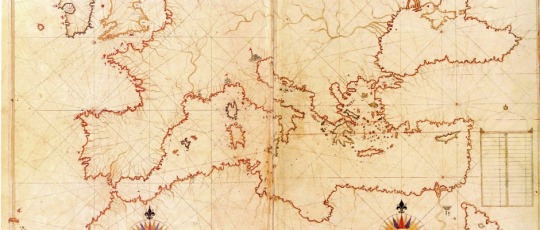
"Oh the one who pleases my heart, how we used to travel around the Mediterranean Sea, around the Arab lands and Rome and France. I have recorded all of the places that stand, whether they be lowlands or high up, so that I may transmit this knowledge."
...Blue…
:::A relevant memory block, later by approximately 4 centuries is found. Skipping to initially requested timeframe.::: ...Blue...
:::Gravitational simulation loading… Please wait…:::
...It was all blue…
:::Sensory nerveous system inputs loading… Please wait…:::
...Why was it all blue?...
:::Accessing memories… Ashina Sungur. Memory date estimated: late 1st quarter of 11th century.:::
...BLUE..
“Y DNA Genetic trace suggests an individual of Central Asian origins…”
“Blue Sky** be with you, Sungur! May your path never end!” Sungur heard the voice, nodded and smiled to his older brother’s goodwish. He held onto his horse’s reins even stronger. He was leaving, finally seeking his own destiny but it meant leaving everything and almost everyone he held dear, everything he was born into and grew alongside.
Such was the way of nomads.

By his side, half of his father’s oba** that decided to come with Sungur, he was tasked with finding a new home for the Clan Ashina and its people. Staying was not an option, their law dictated both siblings, Sungur and Aksökö divide what land their father left them after his death. Aksökö, being the older one had a lot more popularity than Sungur and were to eventually claim all of the Ashina land for himself as soons as he gets an heir, so the two would eventually clash.
Sungur knew this because they were old royalty. It was the more powerful Ashina’s duty to prevent the chieftain line from branching. Their cousin clan, Ashida, made the mistake of tolerating root and branch clans, the resulting civil war almost erased their name from the face of the steppes.
“May your yurts ever multiply, Aksökö” said, Sungur. for the last time, then turned his horse’s face to west. His horse instinctively switched to travel speed as he held up the banner of his clan, carrying Ashina’s coat of arms or rather their symbolic “tamga** of the raven” as he rode to the leading front of the convoy of people that are ready to follow him.

And to the west they rode, first, through a small desert; then came the rocky fields. When they reached the Khazar land to the north, they were more or less close to the third anniversary of the start of their journey. Sungur led his people with greater wisdom than it was expected of his age. He was calm, calculated, thorough in his every decision. Sungur was keen on making new connections from the Oghuz and Kipchak Turkish Clans who just recently started to reign on these lands to find his clan a place to live. Ashina’s formal royal status did little to help him on his endeavour, as it was a reason enough to make any Khagan or bey** uneasy while allowing a clan this old and this large into their holds. Every bey Sungur made a connection advised him to travel further west or go south to join in with the young Seljuk Empire as soon as possible, as they had an already somewhat established control over the land and needed fresh cannon fodder clans to brace the might of Byzantines on the southeastern Anatolian Border. Persians’ distaste for Seljuk Turks’ control over their land was also well known and placing clans like Ashina would also prove them useful in terms of culturally dominating the area.

:::“We are getting close to the desired geography, doctor.::: :::”Hardly means anything. We’re still a few years off from Sabbah’s birth”.:::
Sungur aimed to reach to Nishapur. To walk the streets and talk with people. Learn who is who before making any awkward introductions with powerful people and getting pushed around. Ashina’s young chieftain took thirty of his men and traveled south to Seljuk capital. Approaching the city as a traveling caravan, he wandered the town’s dense streets to a point he can map them. Things he saw left him in awe. He was a steppe man, he grew up in a large oba but had never graced his sights with an architecture quite like Nishapur’s. Buildings, temples with domes and towers piercing the blue skies was displaying the perfect mixture of sharp edges and curvy outline of middle eastern architectural sense at the same time. “Persians sure does know how to build things.” he thought. Sungur later learned that these temples were of the religion of Islam which was dominant there. Blue turquoise was mined here and the gems were under open display as they were covering every possible facades of the mosques. It looked like the marbling and turquoise art of every kind was supplied to the world from this town, although Egypt’s Sinai was known to be a close competition. Even pavings of the streets had some form of pattern art made of marbles that embellishes the simplest of neighborhoods.

Nishapur was a diverse city. Traveling merchants from east to west, north to south all had their own districts and caravansarais to stay when they entered the city. Turks, if not royalty, were living outside the city because they preferred tents to solid walls. Persians, under the rule of Seljuks were still living in their ancestral homes, although their lands were confiscated for Seljuk’s own iqta.** Greeks, Armenians and Jews had a minor presence in the city too. Bustling bazaars of Nishapur had so many languages being yelled at to customers from many kingdoms. Sungur crossed paths with a group of Slavs buying turquoise sword sheaths, some Latins hauling silk and salt to their carts, dodgy looking hooded men carefully inspecting the streets from rooftops in a particular neighborhood and even witnessed a fat Egyptian buy opioids from an Indian with the longest grown beard he has seen in his life.
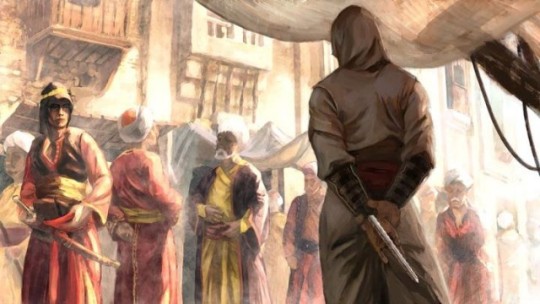
After four days of wandering around, Sungur caught the attention of the city’s security, or whoever it was to be tasked with figuring out what business this unknown warriors of thirty men that claims to be a trade caravan but neither selling nor buying anything in Nishapur. At night, fully armed gulams** with an old scribe came saying that he has to check the trade made by caravan for taxing purposes. Sungur, realizing that his cover as a merchant is blown up, introduced himself as the leader of clan Ashina. He said he wanted to buy supplies for the clan’s main convoy for the way west but found nothing to his interest in the city. Hearing of Ashina name, gulams told the Persian scribe that the man before him needs to be taken to Tugrul Khan.
“Why are you riding around in my city with a false identity, bey?” Said Emperor Tugrul Khan of Seljuks. “You packed up from the fatherland with quite a crowd. While we encourage strong beys like you to join our ranks; a formal hail before your arrival could’ve prevented my cavalry from encircling your main convoy encampment. Imagine my surprise when I found their lost bey within the walls of my city under the disguise of a merchant.”

���I meant no offence, noble Khan. We really did came here with the intention of supplying our convoy, then to be on our way to Byzantine border northwest to Baghdad. Ashina is crowded and we want to cause no problems to the establishment of the young empire you founded. We will carve our own territory to the west around Dogubeyazid and....” “A-a-a-a!” Interrupted, Khan. “What makes you think, that I’ll let you pass, bey? What makes you think that I don’t want Dogubeyazid and beyond, even Constantinople for myself, for my young empire?” “My Khan… I.. I assumed…” “You assumed too much, Sungur Bey. You will settle to wherever I see fit for your clan. But only, for a short time. I will give you a vast herding land and some autonomy near Caspian Sea. You, in turn will take your forces to my army when I demand.”
Sungur agreed, they talked terms. In several hours, they have found a special kind of sense of humor in eachother and Sungur realized, for all his dominance and agressiveness, Khan liked jesting around. Sungur realized this is a different breed of leader he’s talking with. Educated, literate, he was referencing of philosophers of ancient Greek when forming an argument, assuming Sungur already know them. Sungur wished he did. Khan gifted him a horse, couple dozen Seljuk banners that depicts an Öksökö the legendary two headed eagle, a guide tasked with showing them their new land, what rules to follow. He bowed as low as possible before exiting.
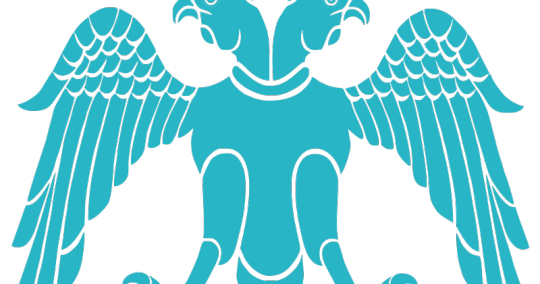
When Sungur reached south of Caspian Sea, Seljuk lords saw it reasonable to make Ashinas settle near Ak Yayla for couple of years, until Tugrul Khan of Seljuks, now a friend of Sungur decided their fate. Sungur made several raids to Byzantine borders with his alps**, atamans** and lesser beys. He eventually fell in love with a golden haired shield maiden from northern Tatars, Altun Khatun** whom he met during a raid. Despite her father’s objections, she loved Sungur too and the two eventually married. Altun’s younger brother, Jeng, also joined up with Ashinas and quickly became Sungur’s right hand man. Sungur trained, met people, learned Arabic, some Farsi, even some Greek. At the fourth summer there, Altun gave the family a daughter, they named her Alchin. And at the fifth... :::Warning: Birth trauma imminent. Flow of genetic data suggests a change in memory subject.:::
“It’s a boy, Sungur Bey. You have a son.”
:::Initial scan complete. Possible names and aliases listed as…:::
“As we agreed with Altun, let it be known that he’s called...”
:::Ashina Tugrul:::
:::Ataman:::
:::Hidden One:::
:::and Assassin:::
Database/Codex Entries Below:
Blue Sky: The Deity most Turks and Mongolians worshipped before majority of Turks switched to Islam.It was also known as Gok Tengri, and was the Zeus-like head of the steppe pantheon of gods.
Oba: A tent town made of “yurts”. Often different places for winter and summer settling.
Tamga: A mixture of coat of arms and a letter-like symbol of a deity, a society or a noble house. Clan Ashina’s tamga was raven, but as you might notice, it didn’t resemble one at all and tamgas had no place in Turkic alphabet to begin with.
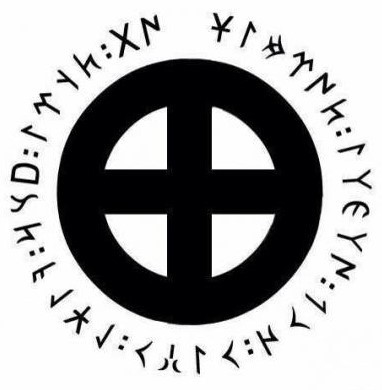
Figure: Tamga of Blue Sky Tengri with inscription: “Öd Tengri yaşar kişioğlu kop ölgeli törümiş.” “Only gods really live; mankind has bred to die.”
Bey: Oghuz Turkish word for “lord” or “sir”.
Iqta: The Middle Eastern feudalic system when an individual or a family is awarded with personel land in exchange of covering the expenses of some particular soldiers of high class. The system survived under the name of timar and gave rise to the infamous timariot class of soldiers in Ottoman times until around 16 to 17th centuries.
Gulam: Elite soldiers of Seljuk Khan. Consisting of Turkmen clans like Ashina who recently migrated to west. Tasked with protecting the Khan himself in the capital. The just like the word “Mamluk” in Arabic, the word “Gulam” originates from “Slave” in Persian which Turks basically was when they arrived to Middle East as paganist refugees from Chinese war. Turks’ beliefs meant they could not be equal citizens like Christians or Jews. Muslims gave control of the cavalry of their army to the Turks and allowed them to live outside of the walls of their cities. In time, more and more Turks arrived and they used the military control they were given to usurp the old regime, both in Egypt(which led to the birth of Mamluk Sultanate) and in Persia. Although Seljuk’s case were more of a brute force case rather than a political scheme.
Alp: Means “brave”, alp-hood was somewhat equivalent of knighthood of Europe; although anyone could become an alp and it was not an inherited title for nobles.
Ataman: A warlord title of Cossacks and Tatars. Ashina Tugrul is half Tatar from his mother’s side, so I figured he can use the title. He will be called Ataman by his uncle Jeng, who is also an Ataman, somewhere in his lifetime.
Khatun: Old Turkish word for “lady” and the root of current Turkish word for “woman” which originates from the word that is more or less similar to “shield maiden” or “female warlord” in ancient Turkic.
#Assassin's Creed#assassin's creed: resurrection#fanfic#assassin's creed fanfiction#assassin's creed fanfic#Turkish assassins
0 notes
Text
Update on Assassin’s Creed: Resurrection
First episode of my fanfic Assassin’s Creed story is done! I’ll try and figure out how to make proper use of Tumblr and post it tomorrow. I welcome anyone willing to help me find a community and how to be less awkward in Tumblr. Here is a teaser for what’s to come tomorrow.

Nishapur was a diverse city. Traveling merchants from east to west, north to south all had their own districts and caravansarais to stay when they entered through the walls. Turks, if not royalty, were living outside the city because they preferred tents to solid walls. Persians, under the rule of Seljuks were still living in their ancestral homes, although their lands were confiscated for Seljuk’s own iqta.** Greeks, Armenians and Jews had a minor presence in the city too. Bustling bazaars of Nishapur had so many languages being yelled at to customers from many kingdoms. Sungur crossed paths with a group of Slavs buying turquoise sword sheaths, some Latins hauling silk and salt to their carts, dodgy looking hooded men carefully inspecting the streets from rooftops in a particular neighborhood and even witnessed a fat Egyptian buy opioids from an Indian with the longest grown beard he has seen in his life.
Database Entries:
** Iqta: The Middle Eastern feudalic system when an individual or a family is awarded with personel land in exchange of covering the expenses of some particular soldiers of high class. In Seljuks, the system was also known as timar, and sipahis, Seljuk’s Khan’s elite soldiers, were also known as Timarli Sipahis because of that.
#assassin's creed#assassin's creed: resurrection#assassin's creed fanfiction#fanfic#I'm a newbie in need of help and I like long tags
0 notes
Text
Spoilers alert: Potential Isu theory of AC Rogue in Origins DLC the Hidden Ones
Don’t click keep reading if you don’t want to be spoiled.
Okumaya devam et
232 notes
·
View notes
Photo

definitely safe for work
2 notes
·
View notes
Photo

Okay, here comes the sketch dumping time. Meet the guy who will be the main character of the Assassin's Creed story series that I'm gonna start posting soon on this blog. It'll take place in Seljuk Empire Era Persia, Egypt and Syria; have strong ties to people like Hassan Sabbah, Omar Khayyam, Nizam-ul Mulk, Bayek of Siwa, Rashiduddin al Sinan or better known as Al Muallim, İshak Pasha and many others.
1 note
·
View note
Photo

Reblog Gal Gadot as Batman for 10,000 years of good luck
141K notes
·
View notes
Text
I wanna bite off a fat chunk of hardware from my laptop rn
Been designing a suspension bridge non stop for 37 hours. Due time is next hour, only half the job I should've done by now is done.
1 note
·
View note
Note
Hello! and welcome to tumblr!
Here comes my first follower! Thank you for the warm welcome, usta.
3 notes
·
View notes
Photo

Wanted to re-activate this blog after 5 years of absence. I’ll dump Assassin’s Creed related sketches and I plan on starting to publish a very historically detailed fanfiction story called Assassin’s Creed: Resurrection that takes place during the historical “origins” era of the Assassin Brotherhood, 11th century Persia. For now, enjoy my attempt at designing a Turkish Assassins/Hidden Ones insignia.
1 note
·
View note
Video
I shouldn't have been crying like this. :( It's the only game that you can feel REAL emotions to imaginary people, even to aliens.
youtube
‘Reignite’ - Malukah
8 notes
·
View notes
Photo
Oh a spider with an assassin insigma on it's back is cute.
..... But it doesn't change the fact that it is a big, creepy assaspider...

Spider that lives in my garage joined Brotherhood and became the Assassin. You can imagine my face, when I saw that hahah! :D
2 notes
·
View notes
Photo

1 note = 1 pixel for your fandom’s symbol (shown above) in an art piece I’m making
If you would like to see all of the fandoms, look through these posts
IF YOU DON’T SEE YOUR FANDOM, send me a message saying what fandoms I missed and I’ll add them
If you would like to know more about the project, read this post
FOLLOW ME TO KEEP UPDATED ON THE PROJECT/SEE THE FINISHED PROJECT
5K notes
·
View notes